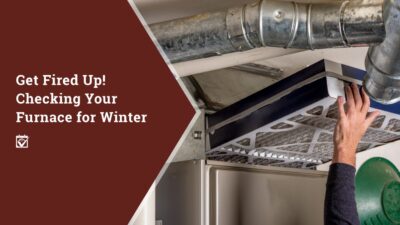
When the last of the brightly colored leaves cling tightly to otherwise bare trees, you know that winter is coming. It’s a sad state of affairs, but happens every year, just like clockwork. The sleet, the snow, the ice, the cold, it all comes in a cycle, and because of that, you need to be paying particular attention to your furnace this time of year. Even if it hasn’t yet started raining down frozen apocalypse upon your head where you live, being ready for the day you’ll have to kick the heat on is a good idea. After all, you don’t want to find out that your furnace isn’t working properly when there’s a foot of snow in the forecast.
Furnace Basics
There are a lot of different kinds of ways to heat a house, but this article is about furnaces in particular. A furnace is a complex piece of equipment that not only contains a heat source, but also a blower to distribute heat throughout a home using a duct system. It’s part of a larger HVAC system, which generally also includes an air conditioner or heat pump. They can be mounted in attics, crawlspaces, garages, basements, and even outdoors in the right situation.
You should already be performing basic maintenance on your HVAC system, no matter what season. This would include items like changing the furnace filter (or cleaning it if it’s an electrostatic one) and flushing the condensation line. Keep those up, even in the winter.
Getting Ready for Winter
As for winter-specific tasks, your furnace should have a pre-launch check at least yearly. If you’re already using it for heating, it’s not too late, just remember to do this before you fire it up next year. Go through this list and hit all the items on it:
- Thermostat. Likely you use your thermostat year-round, but if you don’t, check that your furnace will come on and go off with the control on the wall. If your thermostat is very old, it might be a good idea to replace it with a programmable or smart thermostat to help you save more fuel or electricity this winter.
- Pilot light. Older gas or propane-powered furnaces often have a standing flame pilot light, which is exactly what it sounds like. It’s a fire in your house. All the time. Make sure the pilot light is actually lit if your furnace has one, otherwise you’re gonna be cold, and there’s also a chance gas is leaking in your home. If it’s a newer furnace, it likely has an electric ignitor, which will light the furnace automatically when it kicks on. If you’re not getting heat from a furnace with an electric ignitor, follow the instructions on your furnace to reset it; if that fails, try resetting the breaker.
- Detectors. Smoke and CO2 detectors should be checked regularly, but definitely before you fire up the furnace. They have test buttons on them for this purpose. If they don’t go off, check the batteries or connections if they’re hardwired. Any detectors that fail inspection should be replaced immediately.
These are all simple things you can do to get ready for furnace season. However, there are a few other tasks that you should call an expert in to check or maintain.
When to Call in the Pros
Obviously, you’ll need to call a pro if your furnace won’t come on despite your best efforts. But you should also have an HVAC professional out to clean the air handler, flame sensors, and other vital parts of your furnace. Some DIYers might be able to do this with no issue, but for the general public, it’s safer and much smarter to call someone who knows furnaces inside and out.
Where would you find such a person? Well, in your HomeKeepr community, where you can search for an HVAC professional in your area. It’s great to know that the pros you’re working with have been used by the people in your own networks and found to be at the top of their game.
Source – HomeKeepr

